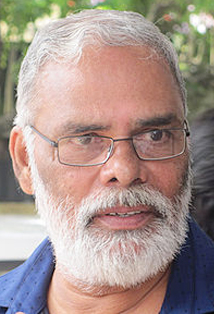T V Chandran

| Alias | Chandran |
|---|---|
| Age | 67 years |
| Height | 5'7" |
| Occupation | Actor |
| Language Worked in | Tamil, Malayalam |
| Eye Color | Black |
| Hair Color | Black |
| Religion | Hinduism |
| Marital Status | Married |
| Favourite Cuisine | South Indian |
| Favourite Color | Red |
| City | Chennai |
T. V. Chandran is an Indian film director, screenwriter, and actor, predominantly working in Malayalam cinema. Born in a Malayali Hindu family in Thalassery, Chandran worked as a Reserve Bank of India employee before entering into the film industry. He started his film career as an assistant director to P. A. Backer and John Abraham. He also acted the lead role in Backer's highly acclaimed political drama Kabani Nadi Chuvannappol (1975). He made his directorial debut with the unreleased feature Krishnan Kutty (1981), and followed this with the Tamil film Hemavin Kadhalargal (1985). Chandran came into prominence after Alicinte Anveshanam (1989), which was nominated for the Golden Leopard at the Locarno International Film Festival. This was followed with Ponthan Mada (1993), his most famous film to-date. Chandran is most known for his art-house films which have references to history and undertones of politics and feminism.
He is also known for his trilogy on 2002 Gujarat riots, consisting of Kathavasheshan (2004), Vilapangalkappuram (2008) and Bhoomiyude Avakashikal (2012). Other highly acclaimed films include Mangamma (1997), Danny (2001) and Paadam Onnu: Oru Vilapam (2003). Chandran is widely regarded as one of the finest directors in Indian cinema and is widely credited with having revolutionised parallel cinema with his complex-structured art-house films. Chandran has won several film awards including six National Film Awards and ten Kerala State Film Awards. In addition to these, he is a recipient of a number of awards at various International film festivals.
T. V. Chandran was born in Thalassery, Malabar District, Madras Presidency, the present day Kannur District, Kerala, to Narayanan Nambiar and Karthyayini Amma. After graduating with a degree from Christ College, Irinjalakuda,[2] and a post graduation from Farook College, University of Calicut, he embarked on a career as a Reserve Bank of India employee before starting his film career. In his college days, Chandran was sympathetic to naxalite ideology and was closely associated with the Communist Party.
Chandran's son Yadavan and brother Soman are also fimmakers. Yadavan has directed docu-films and has assisted Chandran in many of his films. Soman is working an assistant with Chandran right from his first film.[5][6] Chandran's attachment with his other brother, who died in Nigeria in the 1980s, later inspired the film Sankaranum Mohananum.
Chandran debuted as a director with Krishnan Kutty (1981). A critical and commercial failure, this experimental film did not even had a wide public release. The film represents a continuation of P. A. Backer's style of independent film. Chandran's next venture was the Tamil feature film Hemavin Kadhalargal (1985).
This film had Delhi Ganesh and Anuradha in the lead roles. The film marked the debut of the latter, who dominated the Tamil cinema for quite a long time. Though Hemavin Kadhalargal was a commercial success and garnered favourable reviews, Chandran got his much needed break only with his third venture Alicinte Anveshanam (1989). A mystery film by genre, it narrated the journey of a lady in search of her missing husband. It was the official entry from India for the Locarno International Film Festival, and got a nomination for the Golden Leopard.
 'Party' gets an auspicious launch in Chennai
Director Venkat Prabhu's upcoming multistarrer 'Party' has been launched with a formal pooja today. The pooja happened at a temple…
'Party' gets an auspicious launch in Chennai
Director Venkat Prabhu's upcoming multistarrer 'Party' has been launched with a formal pooja today. The pooja happened at a temple…
 ''THIS IS SUCH A WONDERFUL TAKE ON OK KANMANI''
The trailer of OK Jaanu, the official Hindi remake of Mani Ratnam's OK Kanmani, was released on the 12th of…
''THIS IS SUCH A WONDERFUL TAKE ON OK KANMANI''
The trailer of OK Jaanu, the official Hindi remake of Mani Ratnam's OK Kanmani, was released on the 12th of…
 OK JAANU TRAILER REVIEW
OK Kanmani’s official Hindi remake, Ok Jaanu’s trailer is out. The cast of the film includes Aditya Roy Kapur playing…
OK JAANU TRAILER REVIEW
OK Kanmani’s official Hindi remake, Ok Jaanu’s trailer is out. The cast of the film includes Aditya Roy Kapur playing…
 Muhurtam Fixed For Mahesh - Koratala Film
Much awaited Mahesh Babu’s film with Koratala Siva will be launched on November 9 with a formal pooja ceremony. Regular…
Muhurtam Fixed For Mahesh - Koratala Film
Much awaited Mahesh Babu’s film with Koratala Siva will be launched on November 9 with a formal pooja ceremony. Regular…
 Chandran and SatnaTitus complete an important phase
Starring ‘Kayal’ fame Chandran and Satna Titus in the lead roles and with Radha krishnan Parthiban in a role that…
Chandran and SatnaTitus complete an important phase
Starring ‘Kayal’ fame Chandran and Satna Titus in the lead roles and with Radha krishnan Parthiban in a role that…




